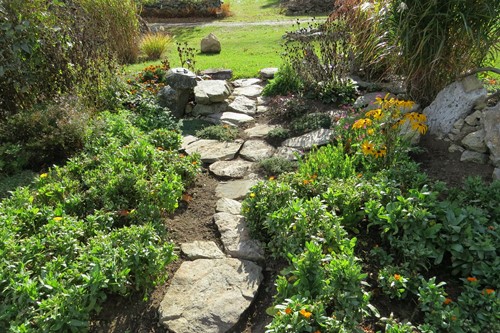Email: [email protected]

Image by Nancy Buron from Pixabay
If you're like many homeowners who prefer a natural landscape plan, your outdoor living space undoubtedly features lush vegetation and bright, blooming flowers. However, you might also have the sense that something is missing but can't quite put your finger on what it might be. If this describes you, the missing element is probably hardscaping. Hardscaping refers to elements of landscaping that aren't plants, such as water features, statuary, gazebos and garden paths.
At its best, hardscaping brings functionality to the table as well as enhances aesthetics. Few things do this better than a rustic stone walkway meandering over the property. Here's how to make it happen yourself over the course of an average weekend.
Stones used for walkways should be flat, wide and thick enough to withstand foot traffic. Choosing stone that is found naturally in your area cuts down on retail and delivery costs. Avoid using polished stones because these present potential slip-and-fall issues due to their slick surfaces. Stones that are between two and three inches thick offer better stability than their thinner counterparts and often come with a more attractive price tag as well.
The first step is to determine your walkway. Avoid straight lines -- stone walkaways are meant to meander. Garden hoses are ideal for marking garden paths that curve. Use a sod cutter and a flat spade to cut and remove the grass, and dig out the soil where you want to place the stones to about a depth of five inches and make sure it's firmly tamped down before placing landscape fabric and adding a two-inch layer of sand over it.
After smoothing down the sand so it provides a flat surface, it's time to lay down the stones. This part is a little like putting together a jigsaw puzzle, so take your time to figure out the placement. Be sure to use a carpenter's level to make certain that the stones are at the same height, and add or remove sand as needed. However, if you live in an area that receives significant amounts of precipitation, slightly sloping the larger stones toward the outside of your walkaway helps prevent standing water issues.
Some people prefer the clean, austere aesthetic of pebble or oyster shell mulch in the gaps between the stones, while others like the rustic, tousled look provided by low-growing herbaceous plants. Corsican mint is an excellent choice because it has a bright green color all year round and releases a divine, minty aroma. Other choices include creeping thyme, rock cress, artemisia and sedum. You can also mix it up with a variety of ground covers for a classic, cottage garden look.

Active in residential brokerage since 1985, Michael enjoys a loyal following of past buyers and sellers. Prior to entering brokerage, he studied culinary arts and managed restaurants in the Boston area. Born and raised in Newton, Michael is very familiar with the Greater Boston area. His seven-day-a-week commitment to his profession serves his clients and customers well. His educational background includes The Johnson & Wales Culinary Institute, The Lee Institute for Real Estate, and The Tom Hopkins and Floyd Wickman Sales Training courses.
In recognition of his completion of the prescribed courses in real estate practice and ethics, Michael has earned the distinguished GRI (Graduate, Realtor Institute) designation. He continues his long-standing membership in the National Association of Realtors and is an avid fly fisherman, musician, and outdoor enthusiast.
Michael was awarded the International President's Circle Award for sales expertise, market knowledge, and dedication to clients for 2020 and 2021. In 2022 and 2023 he was awarded the International Presidents Elite Award, representing the Top 2% of Hammond Residential & Coldwell Banker Agents Worldwide, for demonstrating exceptional sales production, ambition and his commitment to the Real Estate Industry.